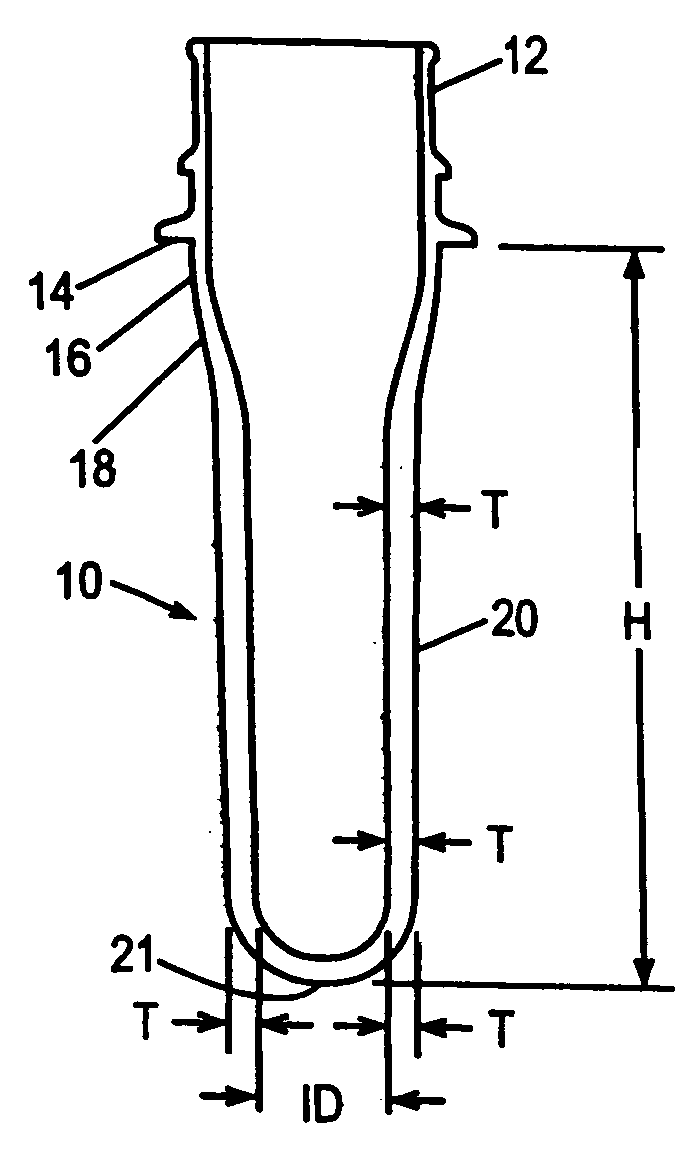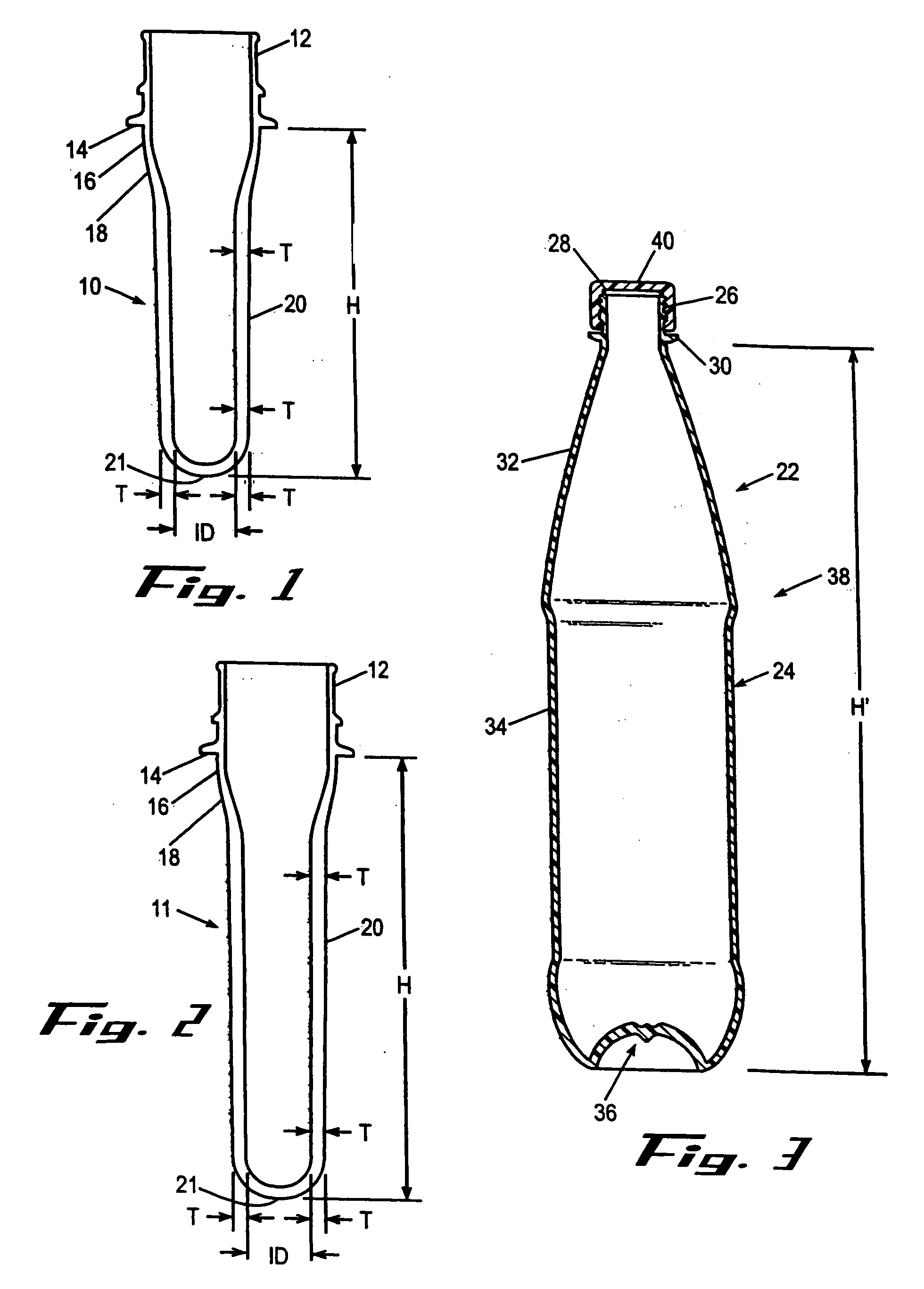Preform for low natural stretch ratio polymer, container made therewith and methods
- Summary
- Abstract
- Description
- Claims
- Application Information
AI Technical Summary
Benefits of technology
Problems solved by technology
Method used
Image
Examples
example 1
[0083] Different PET resins were dried overnight at 135° C. in a vacuum oven to achieve a moisture level below 50 ppm prior to injection molding. The injection molding was performed with a lab-scale Arburg unit cavity injection machine into conventional preform molds using a 25 gram weight preform designed for a 500 ml container with a maximum diameter of 65 mm and a height of 200 mm from below the container finish and having a hoop stretch ratio of 5.5 and an axial stretch ratio of 2.6. The preforms were then free blown to bubbles to determine the stretch ratio of each polymer. Free blow was performed on each preform variable and the bubbles were blown at temperatures of 100° C. and 90 psi. The free blow volume is an indication of the natural stretch ratio of the PET, and is recorded for each bubble. The higher the free blow volume, the higher the natural stretch ratio of the PET.
TABLE 1Free blow results of the LNSR PET copolymer as compared tothe CG PET CopolymerResin Compositio...
example 2
Performance of the LNSR Design
[0088] A preform design conforming to FIG. 2, the LNSR preform design, was used for both 24-g and 27-g preform with reduced wall thickness (that is, having the disclosed relationship between hoop, axial and overall stretch ratio) over the conventional preform designs for a 500 ml contour container. The LNSR PET copolymer resin was then injection molded into these preforms using a lab scale Arburg injection molding machine. This Example demonstrates the cycle time reduction with the thinner sidewall preform. The results are shown in Table 5.
TABLE 5Preform DesignConvLNSRConvCorePreformPreformPreformChangeLNSR PET(FIG. 1)Design(FIG. 1)PreformCopolymer(comp)(FIG. 2)(comp)DesignPreform weight24242727(grams)Hoop stretch ratio4.864.935.244.35Axial stretch ratio2.521.952.341.95Preform stretch ratio12.259.6112.268.48Height (mm)80.74103.9986.95103.99Inside diameter13.6913.5012.6915.30(mm)Wall thickness (mm)3.432.653.862.80Cycle Time (sec)23.617.928.521.0
[0089]...
example 3
[0092] The preform design from Example 2, Table 5, using both control resin C1 (which is a conventional PET polymer) and the LNSR PET copolymer were blown into 500-ml contour containers with a SBO-1 blow molding machine. The thermal stability test was performed according to the procedure as described hereinafter. The thermal stability test is used to measure physical changes in container dimensions caused by temperature and pressure stresses. The thermal stability measurements were made as follows:
[0093] The “as received” test container dimensions and thickness are measured. Containers are then filled with water carbonated to 4.1+ / −0.1 volumes and capped. The filled containers are exposed to ambient temperature overnight, and the dimensions are measured to determine percent change. The containers are exposed at 38° C., and the dimensions are measured to determine percent change. Twelve test samples are labeled with test request and sample numbers on the bottom half of the container...
PUM
| Property | Measurement | Unit |
|---|---|---|
| Temperature | aaaaa | aaaaa |
| Length | aaaaa | aaaaa |
| Length | aaaaa | aaaaa |
Abstract
Description
Claims
Application Information
 Login to View More
Login to View More - Generate Ideas
- Intellectual Property
- Life Sciences
- Materials
- Tech Scout
- Unparalleled Data Quality
- Higher Quality Content
- 60% Fewer Hallucinations
Browse by: Latest US Patents, China's latest patents, Technical Efficacy Thesaurus, Application Domain, Technology Topic, Popular Technical Reports.
© 2025 PatSnap. All rights reserved.Legal|Privacy policy|Modern Slavery Act Transparency Statement|Sitemap|About US| Contact US: help@patsnap.com


